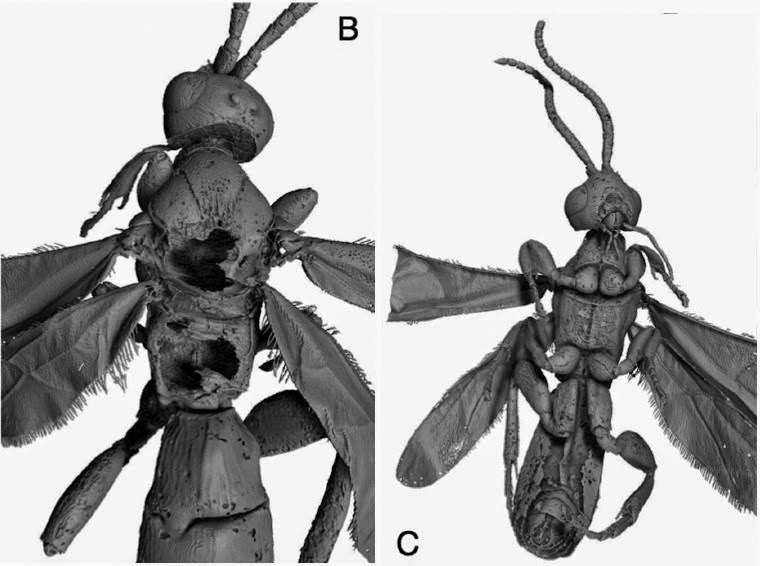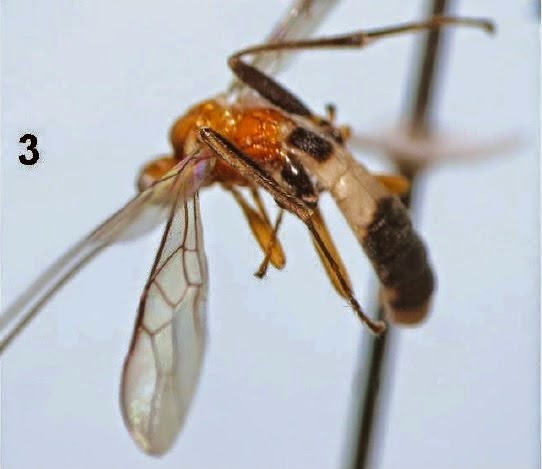Sapygid Wasps are a widespread in northern Eurasia and North
America, but considered rare elsewhere and are unknown in Australia, although
the group are not well studied, and their distribution may be wider than
realised. To date only a few species have been described from South and East
Asia, although the oldest known fossil member of the group comes from
Cretaceous Burmese Amber, suggesting that the group either originated in this
region or has existed there for a very long time. The Wasps are cleptoparasites
of solitary Bees, laying their eggs within the Bees’ nests, where the young
Wasps consume both the larvae of the Bees and the food that their mothers
provision them with.
In a paper published in the journal ZooKeys on 13 January 2014, Cornelisvan Achterberg of the Department of Terrestrial Zoology at the NaturalisBiodiversity Center in Leiden, The Netherlands, describes two new species of
Sapygid Wasps, from Vietnam and Sumatra. Both are placed in the genus Parasapyga, which currently contains
only a single species, Parasapyga moelleri,
which has been recorded from Sikkim State in India and Sumatra, although van
Achterberg considers the Sumatran population of this species to be different
from the Sikkim population (which was described first) and also describes this
as a new species.
The first new species is named Parasapyga boschi,
after the scientific illustrator Erik-Jan Bosch of Leiden, for his excellent
illustrations of the Hymenoptera (Wasps, Bees and Ants). The species is
described from a single female Wasp collected in Cát Tien National Park in
southern Vietnam. In is 18.7 mm in length and black in colour with a reddish
brown abdomen.
Parasapyga boschi, female specimen. Erik-Jan Bosch in van Achterberg (2014).
The second new species is named Parasapyga yvonnae,
after Yvonne van Nierop, who helped in the collection of the specimen from
which the species is named, for her efforts in collecting in North Sumatra. The
species is described from a single female specimen from North Sumatra. The
specimen is 13.9 mm in length, black with an orange-red abdomen.
Parasapyga yvonnae, female specimen. Van Achterberg (2014).
Finally van Achterberg elevates a population of Wasps previously
described from South Sumatra as a subspecies of Parasapyga moelleri to full species status. This population was
formerly known as Parasapyga mölleri
walshae, and now becomes Parasapyga
walshae (modern taxonomy no longer allows accents in species naming, though
these are sometimes encountered in older species; in this case the ‘ö’ has been replaced with ‘oe’ to keep
the pronunciation the same).
Parasapyga walshae, female specimen. Van Achterberg (2014).
See also…
The Betylobraconinae are a group of Braconid Wasps (small parasitoid
Wasps that lack stings and which will lay more than one egg on a host Insect)
found in Australia, New Guinea and New Caledonia. They are abundant within
their range, but their biology is poorly...
Braconid Wasps are small parasitoid wasps (Wasps whose larvae grow
inside the bodies of a living animal host) targeting a variety of Insect
and Spider species. They are unusual in that they will lay multiple
eggs within the same host (most parasitoid Wasps lay a single egg on
each host), thereby allowing multiple larvae to...
Platygastrid Wasps are a large group of (mostly very small) parasitoid
Wasps (Wasps whose larvae develop inside the bodies of a living animal
host), found across the globe. They have a long fossil record, being...
Follow Sciency Thoughts on Facebook.






